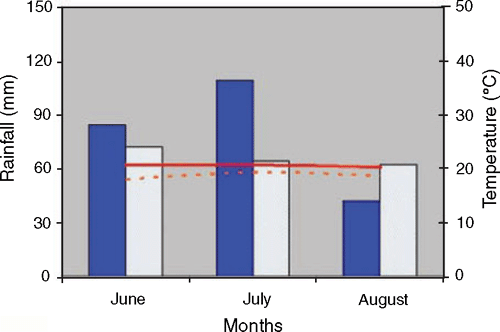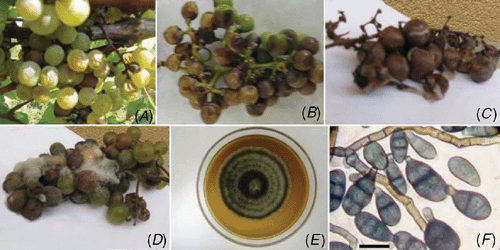First report of Alternaria bunch rot of grapevines in Slovakia
Ľ. Kakalíková A , E. Jankura B D and A. Šrobárová CA The Modra Vintners’ Company, Dolná 120, Modra, Slovakia.
B PPRC – Research Institute for Viticulture and Enology, Matúškova 25, Bratislava, Slovakia.
C Institute of Botany, Slovak Academy of Sciences, Dúbravská 14, Bratislava, Slovakia.
D Corresponding author. Email: jankura@vurv.sk
Australasian Plant Disease Notes 4(1) 68-69 https://doi.org/10.1071/DN09029
Submitted: 9 March 2009 Accepted: 13 June 2009 Published: 29 June 2009
Abstract
Outbreaks of Alternaria bunch rot on grapevines in Slovakia occurred during unusually hot summer weather in 2007 and 2008. This is the first report of this disease in Slovakia. The symptoms of the disease, and the morphological features of the pathogen, Alternaria alternata, are described and illustrated.
A bunch rot causing significant yield losses was observed in some grape-growing areas of Slovakia (Small-Carpathian, Nitrian, South-Slovakian) during unusually hot summer weather in 2007 and 2008 (Fig. 1). The temperatures for the summer periods of 2007 and 2008 were on average 2°C higher than the long-term means. In most vineyards, spread of the disease started in July just before berry-touch and continued until berry ripening. Symptoms were similar to those described by Barbetti (1980) and Hall and Emmett (2001). Tissues of affected berries shrank and turned brown. Berry flesh changed slightly in consistency but remained firm. Skins of the berries were dull and easily detached from the berry flesh. Later, berry skins ruptured, a narrow strip of mycelium appeared along the line of rupture and the mycelium grew rapidly onto other berries (Fig. 2). Rotting berries had no noticeable odour. With time, the berries became necrotic and fell from bunches.

|

|
Alternaria alternata was consistently isolated from infected berries collected from 30 bunches. On malt agar colonies were initially greyish-white, later becoming olivaceous-black or olivaceous-grey with a lighter border. Identification of the fungus was based on microscopic examination of morphological characteristics of conidiophores and conidia (Ellis 1971). The fungus had septate, brown hyphae, short conidiophores, club-like macroconidia with branched transversal and longitudinal septations and notably dark dictyospores (Fig. 2). A voucher specimen has been accessioned as CCF. 2672 in the Department of Botany, Faculty of Science, Charles University, Prague. This isolate was tested for pathogenicity by spraying a spore suspension (106 conidia/mL) onto intact berries detached from clusters without their pedicles. The inoculated berries were incubated in Petri dishes lined with moist cotton at 25 ± 2°C for 5 days. Berries sprayed with sterile distilled water served as controls. Rot occurred on all inoculated berries and the fungus was reisolated from the berries onto malt agar.
Slovakia lies on the northern fringe of the main grape-growing regions of the world. Alternaria bunch rot has been recorded in warmer grape-growing areas (Barbetti 1980; Nair 1985; Swart et al. 1995; Hall and Emmett 2001; Gubler et al. 2006) but has not been reported previously in Slovakia. This outbreak of Alternaria rot, to our knowledge, is the first record on grapevines in Slovakia. The more northerly appearance of this disease may be due to climatic change and the occurrence of warmer summers.
Barbetti MJ
(1980) Bunch rot of Rhine Riesling grapes in the lower south-west of Western Australia. Australian Journal of Experimental Agriculture and Animal Husbandry 20, 247–251.
| Crossref | GoogleScholarGoogle Scholar |

Nair NG
(1985) Fungi associated with bunch rot of grapes in the Hunter Valley. Australian Journal of Agricultural Research 36, 435–442.
| Crossref | GoogleScholarGoogle Scholar |

Swart AE,
Lennox CL, Holz G
(1995) Infection of table grape bunches by Alternaria alternata. South African Journal for Enology and Viticulture 16, 3–6.



